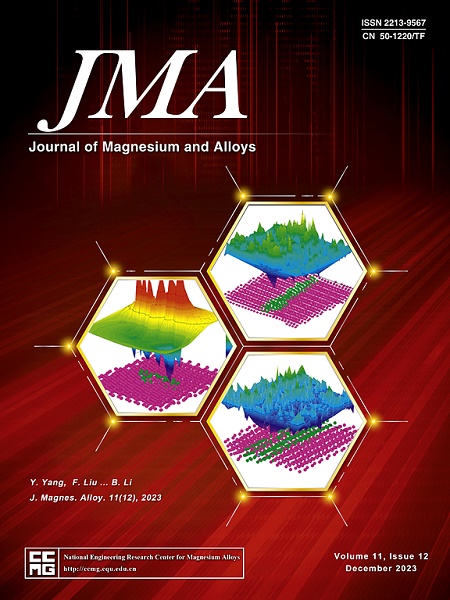可生物降解的镁-钙/镁-铜双层膜,具有更强的机械、成骨和抗菌性能,可用于 GBR 应用领域
IF 15.8
1区 材料科学
Q1 METALLURGY & METALLURGICAL ENGINEERING
引用次数: 0
摘要
具有生物可降解性和优异机械性能的镁(Mg)合金在引导骨再生(GBR)中的应用需求量很大。然而,镁合金的临床应用却因感染风险和有限的成骨能力而受到阻碍。本文采用在线加热轧制技术,在 150 ℃ 下通过各种单程还原轧制出结构功能一体化镁-钙/镁-铜双层膜。镁铜层经过专门设计,具有针对牙龈组织的抗菌特性,而镁钙层则用于支持缺损腔内的骨再生。双层膜的弯曲屈服强度为 421.0 兆帕,模量为 58.6 GPa,显示出卓越的抗变形能力。此外,它还保持了显著的结构稳定性,在 Hanks 溶液中 21 天后仍能保持 86.4% 的体积。体外实验结果表明,双层膜具有良好的生物相容性,并能通过释放出的镁离子和钙离子的协同作用促进成骨。Cu 离子的快速释放和碱性环境的形成进一步提高了抗菌性能,有可能防止术后感染。此外,在体内大鼠腓骨缺损模型中,该膜证明了其刺激新骨形成的能力。总之,镁-钙/镁-铜双层膜具有出色的机械稳定性、良好的腐蚀率,同时还具有非凡的成骨和抗菌活性。因此,它有望在 GBR 应用中成为一种坚固的屏障膜。本文章由计算机程序翻译,如有差异,请以英文原文为准。
Biodegradable Mg-Ca/Mg-Cu bilayer membranes with enhanced mechanical, osteogenesis and antibacterial performances for GBR applications
Magnesium (Mg) alloys with biodegradability and excellent mechanical properties are in high demand for applications in guided bone regeneration (GBR). However, the clinical application of Mg alloys is hindered by infection risks and limited osteogenesis. Herein, a structure-functional integrated Mg-Ca/Mg-Cu bilayer membrane was rolled at 150 °C through various single-pass reductions by using online heating rolling. The Mg-Cu layer was specifically engineered to exhibit antibacterial properties tailored for gingival tissue, while the Mg-Ca layer was designed to support bone regeneration within the defect cavity. The bilayer membrane demonstrated a flexural yield strength of 421.0 MPa and a modulus of 58.6 GPa, indicating exceptional deformation resistance. Furthermore, it maintained notable structural stability by retaining 86.4% of its volume after 21 days in Hanks' solution. In vitro results revealed that the bilayer membrane exhibited favorable biocompatibility and promoted osteogenesis via the synergetic effect of released Mg2+ and Ca2+ ions. The rapid release of Cu2+ ions and the creation of an alkaline environment further improved antibacterial properties, potentially preventing postoperative infections. Additionally, in an in vivo rat calvarial defect model, the membrane demonstrated its capability to stimulate new bone formation. In summary, the Mg-Ca/Mg-Cu bilayer membrane exhibited outstanding mechanical stability, favorable corrosion rates, extraordinary osteogenic and antibacterial activity simultaneously. Consequently, it holds promise as a robust barrier membrane in GBR applications.
求助全文
通过发布文献求助,成功后即可免费获取论文全文。
去求助
来源期刊

Journal of Magnesium and Alloys
Engineering-Mechanics of Materials
CiteScore
20.20
自引率
14.80%
发文量
52
审稿时长
59 days
期刊介绍:
The Journal of Magnesium and Alloys serves as a global platform for both theoretical and experimental studies in magnesium science and engineering. It welcomes submissions investigating various scientific and engineering factors impacting the metallurgy, processing, microstructure, properties, and applications of magnesium and alloys. The journal covers all aspects of magnesium and alloy research, including raw materials, alloy casting, extrusion and deformation, corrosion and surface treatment, joining and machining, simulation and modeling, microstructure evolution and mechanical properties, new alloy development, magnesium-based composites, bio-materials and energy materials, applications, and recycling.
 求助内容:
求助内容: 应助结果提醒方式:
应助结果提醒方式:


